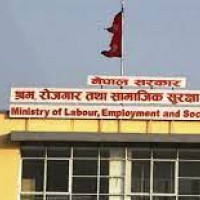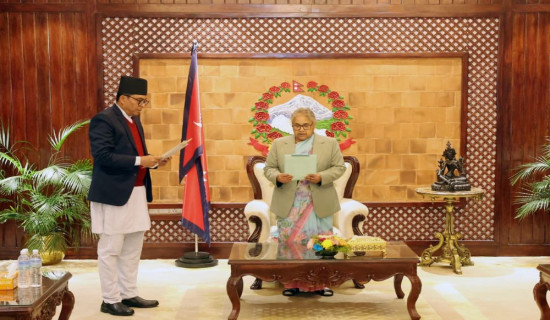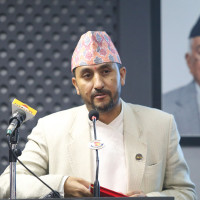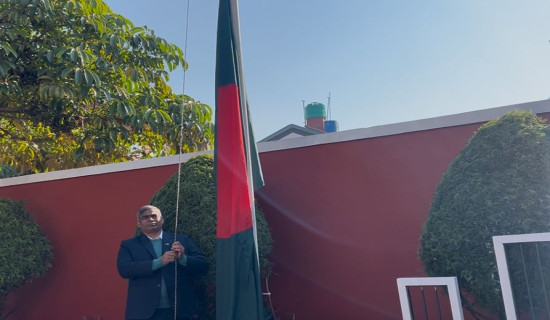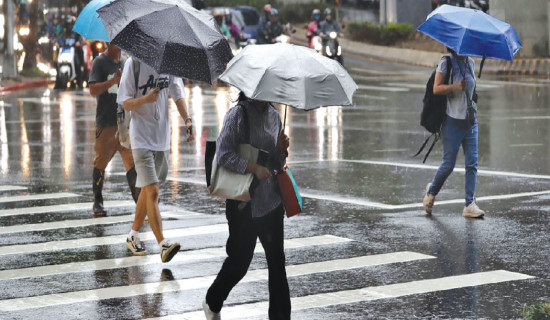- Tuesday, 16 December 2025
Over 7,000 quake-damaged schools rebuilt in six years
Kathmandu, Oct.1: About 7,700 schools destroyed by the devastating earthquake of April 25, 2015, have been rebuilt. Rebuilding those schools in six years after the commencement of the reconstruction drive in 2017 is, no doubt, a big achievement considering the slow pace of all other development works in Nepal.
Looking at the posh new school buildings now standing in the most affected 14 districts, one can realise that the earthquake came as a boon for schools. Obviously, almost all school buildings made of mud and stone were in vulnerable condition before the quake and most of them could not bear the jolts and collapsed, and those which survived the jolt also got new buildings.
Reconstruction of such a large number of schools at a go is a significant milestone in the nation’s recovery efforts following the devastating earthquake.
The earthquake had inflicted damage to 7,923 schools across 31 districts, with larger damage recorded in 14 of these districts. Of these affected schools, about 21,000 classrooms suffered complete destruction, while another 20,000 classrooms sustained partial damage. Additionally, 12,000 classrooms were categorized as being in a mostly damaged condition.
Dilli Ram Luitel, Project Director of the Central Level Project Implementation Unit (CLPIU) under the Ministry of Education, Science, and Technology, highlighted that in the immediate aftermath of the earthquake, students attending these schools were deprived of their education. Therefore, there was a concerted effort to address this issue promptly, including reaching out to donor agencies for assistance. Given the scale of the damage, the Nepal government was unable to solely finance the reconstruction of all the affected schools.
“We initiated the reconstruction process through three different approaches, including utilising our own resources. We collaborated with Non-Governmental Organisations (NGOs) and International NGOs to expedite the resumption of classes in these schools. Through these partnerships, we successfully reconstructed 10 per cent of the total damaged schools,” Luitel said.
Then, the Nepal government allocated funds from its own budget and, in collaboration with the School Management Committees (SMCs), established the Central Level Project Implementation Unit (CLPIU) at the central level and the District Level Project Implementation Unit (DLPIU) at the district level. These units were tasked with disbursing budgets to the SMCs for the purpose of school reconstruction, according to Luitel.
Through the SMC processes, some 6,000 schools were reconstructed, accounting for 80 per cent of the total damaged schools, he said. “For larger schools with a significant number of students and complex infrastructure requirements that could not be addressed through the SMC approach, we sought donors and carried out construction through a tendering process. This process resulted in the reconstruction of an additional 800 schools,” Luitel added.
Besides, 143 schools were earmarked for the retrofitting process. Out of these, 88 schools have already been handed over after the completion of the necessary work, while the remaining schools are still in various stages of reconstruction.
According to him, the Asian Development Bank, the Government of China, JICA (Japan International Cooperation Agency), the Saudi Fund, and the Government of India collaborated in the reconstruction of schools with substantial infrastructure, which is 10 per cent of the total damage.
“Seven schools underwent reconstruction under the turnkey module, with two located in Russia, two in Sindhupalchowk, and one in Kathmandu,” he explained. “One of these schools has already been handed over, while the construction of the others is still in progress,” he added.
More schools were constructed than those that were damaged in the earthquake because, during the reconstruction process, we discovered that some schools were in poor condition and were also rebuilt, he said.
Luitel stated, “We are presently in the project’s final stages and will be handed over it by March 2024. A substantial investment of at least Rs. 60 billion has been allocated over a six-year span for the comprehensive school reconstruction initiative. The Disaster Resilience of School Project is actively ongoing at this time.”
“There could be a variation of up to 10 per cent in the total budget, as a portion of the budget may be required for future maintenance needs in the newly constructed schools. This provision allows for the ongoing upkeep and sustainability of these educational facilities in the days ahead,” he said.
Out of a total of 7,677 schools, 7,561 schools have been successfully handed over to the School Management Committees , with 116 schools still undergoing reconstruction. In the reconstructed schools, 3,453 separate toilets for boys and girls have been constructed, and 2,170 schools have been equipped with essential drinking water facilities. “Other schools were already equipped with drinking water facilities so we do not have to construct new ones,” Luitel said.
We failed to reconstruct a few schools in the 14 most affected districts due to low student enrolment, leading to consideration of school mergers. Additionally, in places like Bhaktapur, some schools expressed a desire for reconstruction using traditional architectural methods (like in the Malla period), which did not align with the prescribed reconstruction model we were following, according to him.
Bhaktapur Municipality stated that they would proceed with the reconstruction of the school in their own way, so we granted them permission to do so, Luitel said.
According to Luitel, all the schools reconstructed at the district level meet the required standards, as they are subject to direct monitoring by the SMCs. In the case of larger schools reconstructed through the tendering process, there are drawing consultants responsible for ensuring the quality of the construction.
As per the agreement between the government of China and the Nepal government, China reconstructed the Kathmandu Durbar High School building which suffered severe damage during the earthquake. The newly reconstructed school boasts of an expansive construction area spanning 4,200 square metres, featuring over 40 modern classrooms.
Ratna Rajya Higher Secondary School, located in Jugal Rural Municipality within the Sindhupalchowk district, underwent a remarkable reconstruction effort sponsored by the Chinese government. This school stands as a shining example of a post-earthquake reconstruction project that adhered to exceptionally high standards in terms of quality and design.
Despite the commendable reconstruction efforts that have elevated these schools to high standards, the management teams have encountered operational challenges. Tika Dutta Poudel, the principal of Ratna Rajya Higher Secondary School, expressed concerns, stating, “While our school now boasts excellent infrastructure, we are currently grappling with management-related issues.”
“The school has become a ‘white elephant’ for the less fortunate. It boasts 140 classrooms, but most of them are allocated for hostel use, resulting in a shortage of classrooms. The reconstruction incorporated the use of tiles, which is unfamiliar to rural students, leading to instances of slipping on the tiled floors due to their lack of familiarity. Additionally, the school is not disability-friendly,” he stated.
At present, the school has a total enrollment of 500 students, offering classes up to grade 12. The school, which spans across 61 ropanis of land, possesses essential sports equipment, including a futsal field.
In a conversation with The Rising Nepal, former Chief Executive Officer of the then National Reconstruction Authority (NRA), Gobinda Raj Pokharel, praised the school reconstruction efforts as one of the success stories in Nepal’s post-earthquake recovery. He noted, “School reconstruction was a critical and successful endeavour, responding to the urgent needs of the local communities. The Nepal government swiftly initiated the reconstruction process, and international non-government agencies played a pivotal role in supporting this vital effort.”




